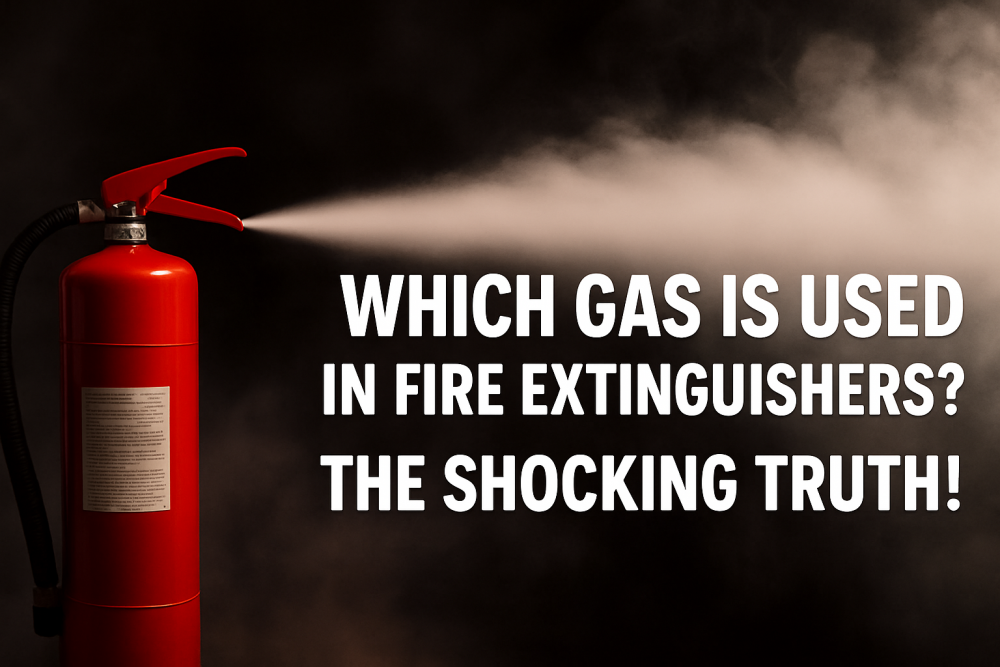
If you ask anyone, “which gas is used in a fire extinguisher?”, most people will give random answers. Some say nitrogen, some say oxygen (which is totally wrong), and some don’t know at all.
But the truth is — different extinguishers use different gases. And every gas has its own job.
So today, let’s clear all the doubts. And once you understand this, you will know exactly which fire extinguisher gas is safe for your home, office, factory, or shop. This guide is from Kanex Fire Solutions Limited, so you’re getting correct and trusted information only.
Why Does the Gas Matter So Much?
Because if you use the wrong fire extinguisher gas on the wrong fire, the fire can actually become bigger. For example, imagine using water on a gas fire. That can explode. Or using a powder extinguisher on sensitive electronics. That can destroy your devices. That’s why knowing which gas is used in fire extinguishers is not just knowledge. But it’s a life-saving skill.
CO2 (Carbon Dioxide): The Most Famous Fire Extinguisher Gas
If someone asks which gas is used in a fire extinguisher, the safest answer is: CO2 Gas.
This gas is used in CO2 fire extinguishers, and it is mainly for:
- Electrical fires
- Computer rooms
- Server racks
- Offices
- Labs
- Factories
Why CO2 gas?
- It removes oxygen from around the fire
- It cools the fire instantly
- It does NOT damage electronics
- It leaves no marks or mess
This is the cleanest fire extinguisher gas used today. If you deal with computers, machinery, or electrical panels, CO2 is the best.
Clean Agent Gas (FK-5-1-12 / HFC-236fa / HFC-227ea)
Many modern extinguishers use clean agent gas. This is very advanced technology — colourless, safe, and super fast. Kanex Fire uses certified clean agent systems that are safe for:
- Server rooms
- Data centres
- Hospitals
- Control panels
- Expensive machinery
Why clean agent gas is special:
- Zero residue
- No damage to electronics
- Safe for humans
- Works faster than most agents
Nitrogen Gas: Used as a Propellant
Here’s a secret most people don’t know. Most extinguishers use nitrogen gas inside. Not as the actual extinguishing agent, but to push the material out.
Example: Dry powder and foam extinguishers fill nitrogen as the pressure gas.
Nitrogen helps:
- Keep the extinguisher pressurized
- Release powder/foam smoothly
- Maintain long cylinder life
So if someone asks about the fire extinguisher gas used inside the cylinder, nitrogen is a correct answer too.
LPG, CNG, PNG, and Other Gas Fires: Special Extinguishers Needed
If you have gas stoves, gas banks, or LPG cylinders, you must know this. You cannot use any random extinguisher on gas fires. The best choice for a fire extinguisher for gas is the Dry Powder Extinguisher (ABC or BC).
Because dry powder cuts the chemical reaction in a gas fire and kills the flames quickly. This is why you should:
- Never use water on a gas fire.
- Never use foam on a gas fire.
- Never go close if the cylinder is leaking.
Which Gas for Which Fire?
| Fire Type | Best Extinguisher | Gas Inside |
| Electrical fire | CO₂ Extinguisher | CO₂ gas |
| Server room fire | Clean Agent | FK-5-1-12 / HFC gases |
| Gas cylinder fire | Dry Powder | Nitrogen as propellant |
| Petrol / diesel fire | Foam or Dry Powder | Nitrogen |
| Kitchen oil fire | Wet Chemical | No gas needed |
The Final Verdict
So now you clearly know that not every fire extinguisher uses the same gas, and not every gas is made for every situation. When you understand this small thing, you stay safer and avoid big mistakes during an emergency. And if you want a trusted fire extinguisher, you can buy it from Kanex Fire Solutions Limited. We have very different options for different fires. You may check our other products here.






